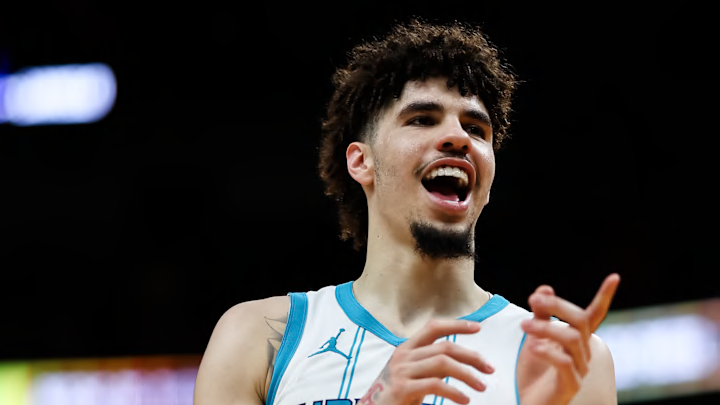LaMelo Ball is the Charlotte Hornets’ identity. Every possession, every offensive rhythm, every flicker of excitement runs through him. When he’s on the floor, the Hornets are a blur of motion and creativity; when he’s out, everything slows to a crawl. The numbers only confirm what the eye test screams — Ball is both Charlotte’s greatest weapon and its biggest variable.
When Ball plays, the Hornets look like a real NBA offense. The team posted an offensive rating of 110.6 with Ball orchestrating, per StatMuse. Without him, that number nosedives. The difference isn’t subtle: Charlotte averaged 108.5 points per game in games Ball appeared in, but fell off sharply when injuries kept him sidelined. It’s a reminder that the Hornets’ entire offensive ecosystem depends on their mercurial point guard.
When Ball is cooking, everything clicks
Ball’s usage rate last season — 35.9 percent, among the highest in league history — tells the story. Nearly every meaningful possession runs through him. He averaged 25.2 points per game, but the more interesting detail is how those points came. Ball’s game blends improvisation and audacity; he’ll step into a 29-foot pull-up early in the shot clock or thread a one-handed bounce pass through traffic for an assist that most guards wouldn’t even see.
That style carries risk. His 40.5 percent shooting from the field and 33.9 percent from three-point range are respectable but not elite, and his 19.1 PER lags behind that of other high-usage creators. The efficiency gap shows up in his decision-making — the same daring passes that create open threes also balloon his 10.3 percent turnover rate, one of the highest among point guards.
Still, the offense hums when Ball is directing traffic. His 7.4 assists per game and 39.0 percent assist rate underline how much he elevates others. Brandon Miller and rookie shooters like Kon Knueppel and Antonio Reeves can benefit from the spacing and movement Ball generates. The team’s ball movement and shot quality dip noticeably when he’s off the floor.
A shot diet that’s both gift and curse
Ball’s confidence is as much a weapon as his passing. He has attempted 8.4 threes per game through his career, hitting 36.5 percent. The problem isn’t volume — it’s shot selection. Too many of those attempts are deep, contested looks early in the clock. Combine that with his limited free-throw rate, and it’s easy to see why his true shooting percentage (54.7 percent) and effective field goal percentage (49.4 percent) sit just below league-average for lead guards.
Those numbers paint a complex picture: Ball can explode for 40 on any night, but his floor is equally low when the jumper isn’t falling. Charlotte’s offensive volatility mirrors his shot chart — thrilling when hot, frustrating when not.
The defensive disconnect
Defensively, Ball’s impact remains the biggest question mark. Scouts and analysts alike have pointed to stretches of “defensive indifference” that weigh down Charlotte’s metrics when he’s on the floor. The team’s defensive rating rises when he plays — not because of scheme, but because of lapses in focus. Ball’s anticipation occasionally produces steals, but he gambles too often and gets caught ball-watching.
Health compounds the problem. Ball has played just 94 games across the past two seasons, and the Hornets’ record in those appearances (16–31) speaks to both his importance and the cost of his absences. When he’s healthy, Charlotte scores and competes. When he’s not, they vanish from relevance.
The path forward
The Hornets’ entire identity revolves around Ball’s creativity. The challenge now is balance. A slightly more measured approach — a few fewer contested step-backs, a few more paint touches, and consistent defensive engagement — could elevate not just Ball’s numbers, but Charlotte’s ceiling.
The advanced analytics are clear: Ball’s presence raises Charlotte’s offensive floor but caps its defensive ceiling. His game is electric, unpredictable, and, at times, unsustainable. The next step isn’t reinvention — it’s refinement.
If Ball can stay on the court, sharpen his shot selection, and show steadier commitment on defense, the Hornets’ advanced metrics might finally reflect what fans believe they see: the beginnings of a true franchise cornerstone, not just a highlight reel waiting to happen.
